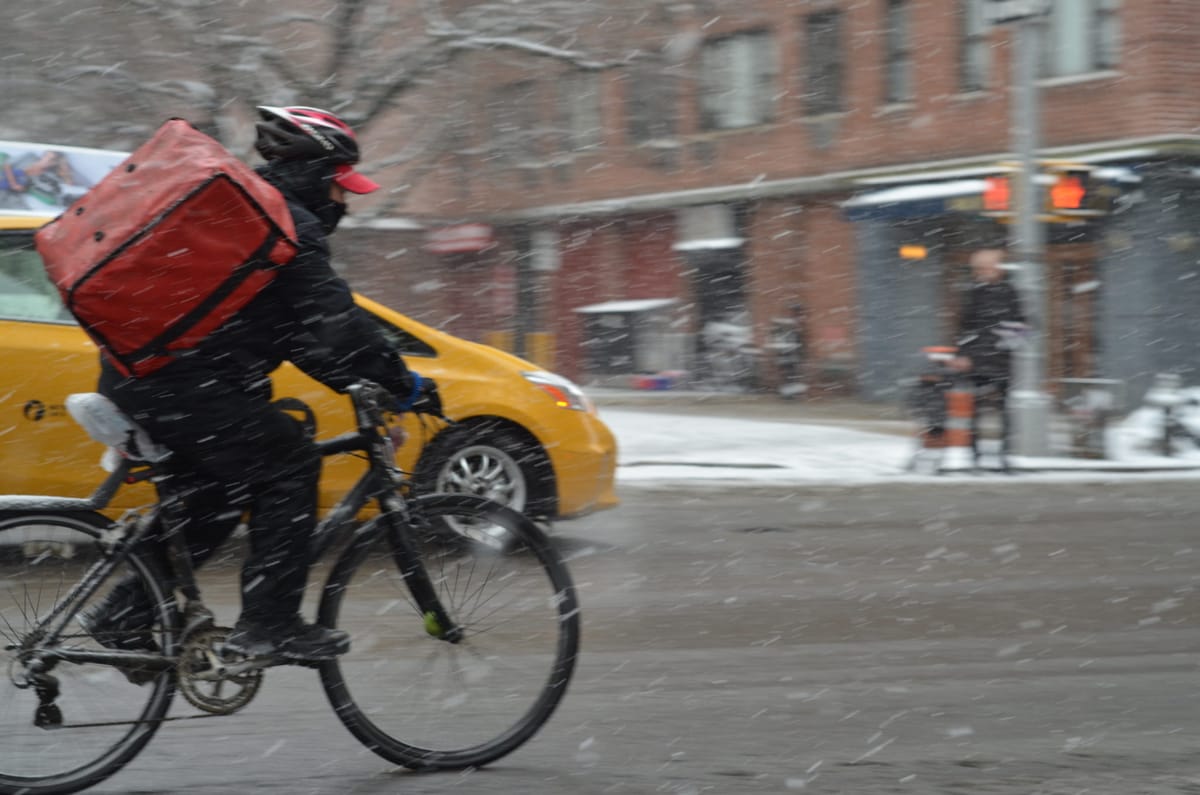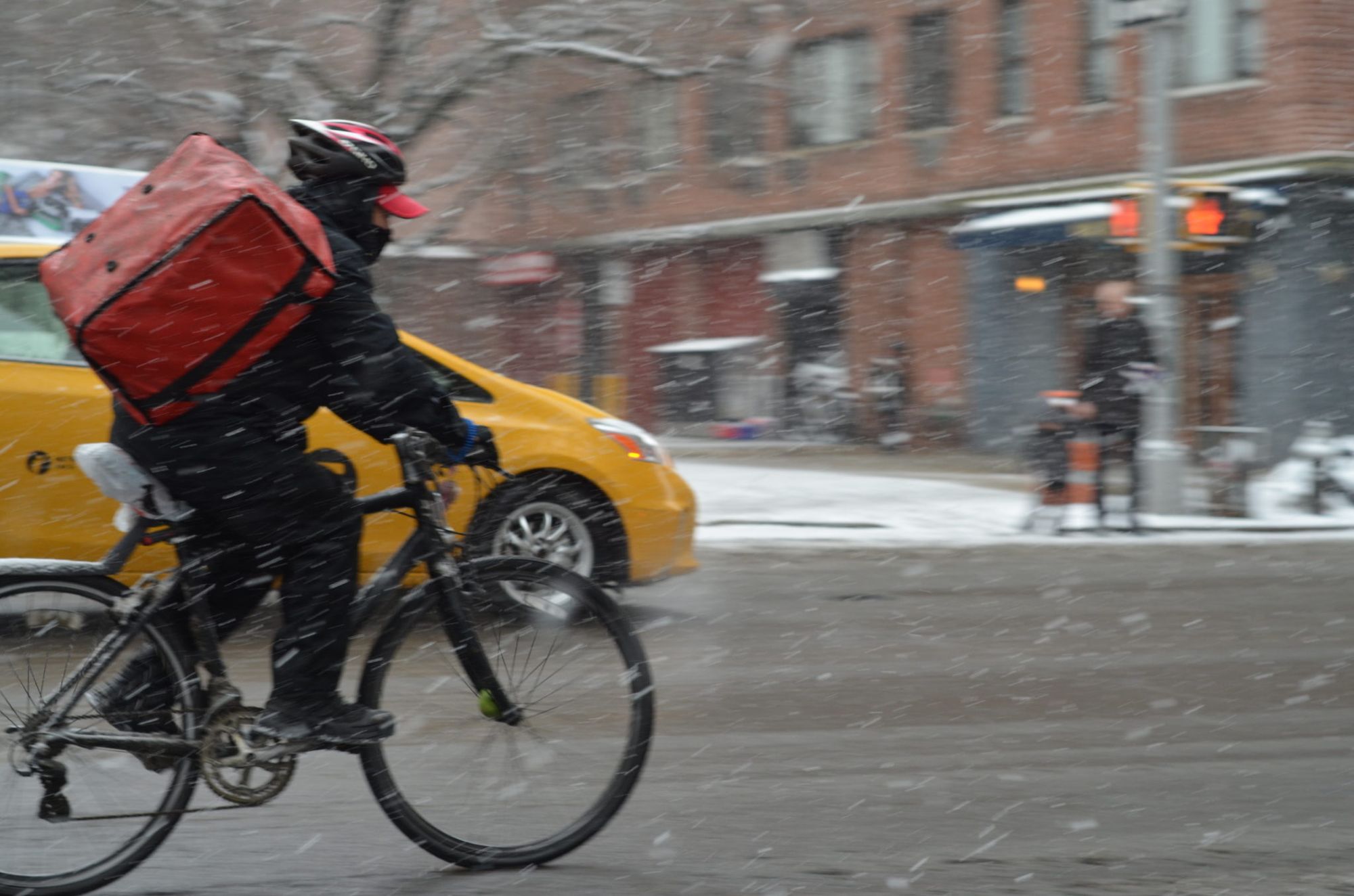More Snow, Starting This Afternoon


If predictions hold, it will start snowing lightly in just about an hour or two, and by the end of the evening, there could be anywhere from 1-3″ of snow on the ground. So get those shovels ready!
The City has issued warnings for the evening rush hour, saying that snow is likely to cause limited visibility and slippery conditions, and folks should be careful when driving, biking or walking.
It looks like the snow will hold, as temperatures are expected to remain below freezing through Saturday, and strong winds will keep windchill temperatures in the 20s all weekend long.
Here are the usual safety tips from the city:
For Motorists
- Drive slowly. Vehicles take longer to stop on snow and ice than on dry pavement.
- Four-wheel drive vehicles may make it easier to drive on snow-covered roads, but they do not stop quicker than other vehicles.
- Use major streets or highways for travel whenever possible.
- Know your vehicle’s braking system. Vehicles with anti-lock brakes require a different braking technique than vehicles without anti-lock brakes in snowy conditions.
- If you are driving and begin to skid, ease your foot off the gas and steer in the direction you want the front of the car to go. Straighten the wheel when the car moves in the desired direction. If you have an anti-lock braking system (ABS), apply steady pressure to the brake pedal. Never pump the brakes on an ABS equipped vehicle.
- Try to keep your vehicle’s gas tank as full as possible.
- Keep the name and phone number of at least one local towing service in your car in case you break down or become stuck.
For Pedestrians
- Exercise caution and avoid slippery surfaces; some ice may not be visible. Wear sturdy boots that provide traction to reduce slipping. Use handrails when using stairs.
- Seniors should take extra care outdoors to avoid slips and falls.
- Have heightened awareness of cars, particularly when approaching or crossing intersections.
- If you have to go outdoors, wear dry, warm clothing and cover exposed skin. Keep fingertips, earlobes, and noses covered. Wear a hat, hood, scarf, and gloves.
- Shivering is an important first sign that the body is losing heat. Shivering is a signal to return indoors.
- Be careful when shoveling snow. Follow your doctor’s advice if you have heart disease or high blood pressure. Cold weather puts an extra strain on the heart.
- Be safe at work. Workers who spend a lot of time outdoors are at risk for cold-related health impacts. If you are an employer, implement safe work practices, provide appropriate protective equipment, and train workers on how to stay safe during cold and winter weather.
- Limit alcohol intake. Drinking alcohol may make you feel warmer but it causes your body to lose heat faster. Alcohol also impairs your judgment which limits your ability to take appropriate precautions or remove yourself from a dangerously cold environment in time. As a result, alcohol actually increases your chances of hypothermia and frostbite.
Prolonged exposure to cold can lead to hypothermia, frostbite, and can worsen existing medical conditions such as heart and lung diseases.
Hypothermia occurs when the body temperature drops to a dangerously low level. It can lead to death. Symptoms include:
- Intense shivering
- Dizziness
- Trouble speaking
- Lack of coordination
- Sluggishness
- Drowsiness
- Confusion
- Shallow breathing
Frostbite occurs when parts of the body freeze, such as finger, toes, ears, nose, and cheeks. It can cause permanent damage. Symptoms include:
- Red or painful skin
- Pale skin
- Unusually firm or waxy skin
- Numbness
Call 911 and follow instructions, or go to the emergency room if you see symptoms of hypothermia or frostbite.
Department of Sanitation
The NYC Department of Sanitation is pre-deploying 693 salt spreaders Friday. PLOWNYC will be activated and with 500 plows will be dispatched when more than two inches of snow accumulates, with additional plows available if necessary.
Department of Social Services
A Code Blue Weather Emergency notice is issued when the temperature is forecast to drop to 32 degrees Fahrenheit or less between 4 p.m. and 8 a.m., including National Weather Service calculations for wind chill values. No one who is homeless and seeking shelter in New York City during a Code Blue will be denied. Should you see an individual who appears to be homeless and in need out in the cold, please call 311 and an outreach team will be dispatched to offer assistance. During Code Blue Weather emergencies, experienced outreach teams work to connect homeless New Yorkers with the following resources:
- Shelters: During a Code Blue, shelter is available system-wide to accommodate anyone who is reasonably believed to be homeless and is brought to a shelter by outreach teams. Accommodations are also available for walk-ins.
- Drop-in centers: All drop-in centers are open 24-hours per day, including when Code Blue procedures are in effect, and will assist as many people as possible for the duration of the emergency. Drop-in staff and the dedicated outreach teams they work closely with each and every day can also make arrangements for homeless individuals at other citywide facilities.
- Safe havens and stabilization beds: Chronically homeless individuals may be transported directly to these low-threshold housing programs.
- Street homeless outreach: Teams will contact vulnerable individuals on their Code Blue Priority Lists a minimum of once every four (4) hours beginning at 8 p.m. during Code Blue Alerts and once every two (2) hours beginning at 8 p.m. for Enhanced Code Blue Alerts to encourage them to accept services, including transportation to a shelter placement. DSS coordinates borough-level Code Blue efforts directly with partner City agencies, including but not limited to NYPD, DSNY, and the Parks Department.




